<< Previous | Displaying results 4401-4425 of 6769 for "" | Next >>
After the trial of major war criminals before the International Military Tribunal in Nuremberg, the United States held a series of other war crimes trials at Nuremberg—the Subsequent Nuremberg Proceedings. The ninth trial before the American military tribunal in Nuremberg focused on members of the Einsatzgruppen (mobile killing units), who had been assigned to kill Jews and other people behind the eastern front. This footage shows US prosecutor Ben Ferencz outlining the purpose of the trial during…
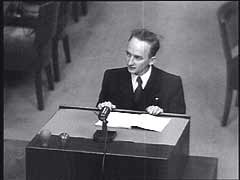
After the trial of major war criminals before the International Military Tribunal in Nuremberg, the United States held a series of other war crimes trials at Nuremberg—the Subsequent Nuremberg Proceedings. The ninth trial before the American military tribunal in Nuremberg focused on members of the Einsatzgruppen (mobile killing units), who had been assigned to kill Jews and other people behind the eastern front. In this footage of the prosecution's opening statement, US prosecutor Ben Ferencz explains…
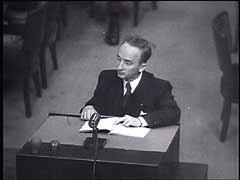
Vidkun Quisling headed the German-controlled government of Norway from 1942-1945. Because of his actions, his name became synonymous with Nazi collaboration.

Nazi supporters parade at a campaign rally in Waldenburg, Germany. In a speech, Hitler attacks the Weimar Republic and pledges to dissolve the parliamentary system soon after he gains power.
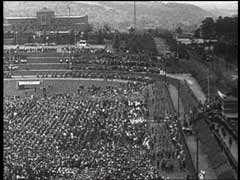
In their drive to rid the country of all that they deemed "un-German," the Nazis publically burned books in cities across Germany. Here in front of the Opera House in Berlin, a chanting crowd burns books written by Jews and leftist intellectuals. Joseph Goebbels, Hitler's minister of propaganda and public information, speaks of the intended "reeducation" of Germany.
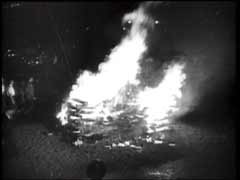
Adolf Hitler's foreign policy aimed at establishing a European empire for Germany through war. This policy required the rapid expansion of Germany's military capabilities. The Geneva Disarmament Conference, beginning in 1932, sought to avoid another European war by negotiating a reduction in armaments. Hitler repudiated this effort by withdrawing Germany from the conference in October 1933. At the same time, he rejected collective security in international affairs by withdrawing from the League of Nations.…
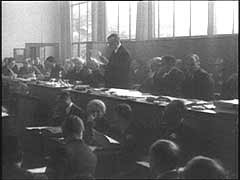
Provisions of the 1919 Treaty of Versailles forbade Germany (defeated in World War I) to station armed forces in a demilitarized zone in the Rhineland—a region in western Germany bordering France, Belgium, and part of the Netherlands. The treaty stipulated that Allied forces—including US troops—would occupy the region. In a blatant violation of the treaty, on March 7, 1936, Hitler ordered German troops to reoccupy the zone. Hitler gambled that the western powers would not intervene. His action…
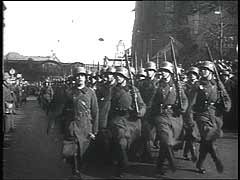
In 1933, Nazi Party leader Adolf Hitler became chancellor of Germany and quickly turned the nation's fragile democracy into a one-party dictatorship. Police rounded up thousands of political opponents, detaining them without trial in concentration camps. The Nazi regime also put into practice racial policies that aimed to "purify" and strengthen the Germanic "Aryan" population. A relentless campaign began to exclude Germany's one-half million Jews from all aspects of German life. For two weeks in August…
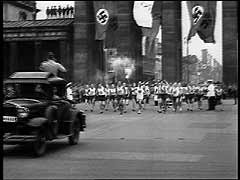
Upon arrival in the Auschwitz camp, victims were forced to hand over all their belongings. Inmates' belongings were routinely packed and shipped to Germany for distribution to civilians or use by German industry. The Auschwitz camp was liberated in January 1945. This Soviet military footage shows civilians and Soviet soldiers sifting through possessions of people deported to the Auschwitz killing center.
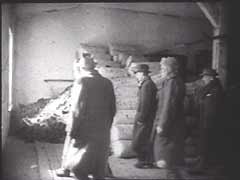
Eva Justin was an assistant to Dr. Robert Ritter, the Third Reich's "expert" on Roma (Gypsies). She studied these Romani (Gypsy) children as part of her dissertation on the racial characteristics of Roma. The children stayed at St. Josefspflege, a Catholic children's home in Mulfingen, Germany. Justin completed her study shortly after this film was taken. The children were deported to Auschwitz-Birkenau, where most were killed.
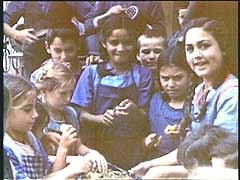
The Hadamar psychiatric hospital was used as a euthanasia killing center from January until August 1941. Nazi doctors gassed about 10,000 German patients there. Although systematic gassings ended in September 1941, the killing of patients continued through the end of the war. In this footage, American soldiers supervise the exhumation of the cemetery at Hadamar and begin the interrogation of Dr. Adolf Wahlmann and Karl Wilig, who participated in the killings.
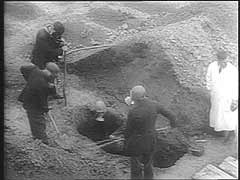
[This video is silent] The Dachau concentration camp, northwest of Munich, Germany, was the first regular concentration camp the Nazis established in 1933. About twelve years later, on April 29, 1945, US armed forces liberated the camp. There were some 30,000 starving prisoners in the camp at the time. This footage shows an aerial view of the camp and the entrance gate to the prisoner compound.
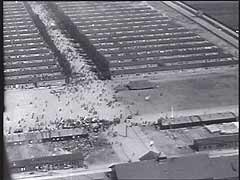
In Nazi usage, "euthanasia" referred to the killing of those whom the Nazis deemed "unworthy of life." In 1941 the Hadamar psychiatric clinic served as one of the euthanasia killing centers in Germany. Patients selected by German doctors for euthanasia were transferred to Hadamar or one of the other facilities and were killed in gas chambers. Over 10,000 people were gassed at Hadamar before the Euthanasia Program officially ended in August 1941. Although the program had officially ended, killings continued…
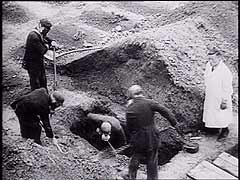
After the trial of major war criminals before the International Military Tribunal in Nuremberg, the United States held a series of other war crimes trials at Nuremberg during the Subsequent Nuremberg Proceedings.The ninth trial of these proceedings, before an American military tribunal, focused on members of the Einsatzgruppen (mobile killing units) who had been assigned to kill Jews and other people behind the eastern front. This footage shows US Supreme Court Justice Robert Jackson, chief prosecutor for…
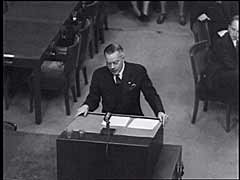
British troops liberated the Bergen-Belsen concentration camp in Germany in April 1945. They filmed statements from members of their own forces. In this British military footage, British army chaplain T.J. Stretch recounts his impressions of the camp.
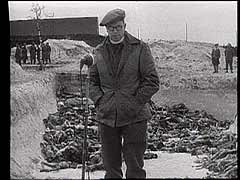
Japanese pilots used the tactic of Kamikaze (suicidal) dive-bombing attacks on enemy warships in 1944 and 1945. The "USS Nevada," despite an escort and efforts to fight off a Kamikaze attack, sustained such a hit in early 1945 off the coast of Japan. The "USS Ticonderoga," a carrier, also sustained such a hit in early 1945 off Formosa (Taiwan). The impact of Kamikaze attacks decreased during the final months of the war in the Pacific, in part because of an improvement in Allied evasion tactics.
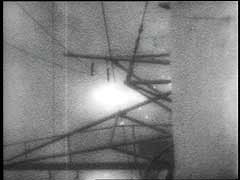
Japanese forces took the Philippine islands between December 1941 and May 1942. After US naval victory in the Battle of Midway (June 1942), Allied forces slowly gained naval and air supremacy in the Pacific war. In October 1944, US forces began the liberation of the Philippines. The campaign on Luzon, largest and most northern of the islands, began in December 1944. This battle footage shows many Japanese soldiers being taken as prisoners of war.

World War II in the Pacific theater ended with the Japanese surrender on September 2, 1945. The surrender was signed in Tokyo Bay aboard the American battleship USS "Missouri." Foreign Minister Shigemitsu headed the Japanese delegation. General Douglas MacArthur accepted the surrender on behalf of the Allies. Admiral Nimitz signed for the US and Admiral Fraser for Britain. Representatives of all the Allied nations attended the signing.

The German-Soviet Pact of August 1939 included a nonaggression pact whereby Germany and the Soviet Union promised not to attack one another for 10 years. Germany was thus able to invade Poland on September 1, 1939, without fear of Soviet intervention. In accordance with secret provisions of the pact, Poland was partitioned between Germany and the Soviet Union. Soviet forces occupied eastern Poland. In this footage, German and Soviet forces meet along the Bug River in central Poland. Less than two years…
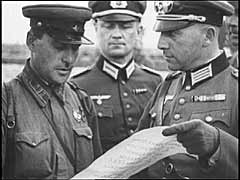
Massive Allied landings of air- and sea-borne forces on five Normandy beaches (codenamed Utah, Omaha, Gold, Juno, and Sword) began on June 6, 1944 (D-Day). The purpose of the invasion was to establish a bridgehead from which Allied forces could break out and liberate France. By the end of the operation's first day, some 150,000 troops were ashore in Normandy. This footage shows Allied forces landing on the Normandy beaches.
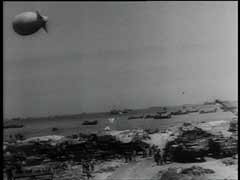
Allied air superiority over Germany was a decisive factor in the success of the D-Day (June 6, 1944) landings in France. This footage shows the Allied bombing of suspected German positions during the battle. Allied air attacks both supported Allied ground operations in Normandy and prevented German reinforcements from reaching the area. The Allies would liberate most of France by the end of August 1944.
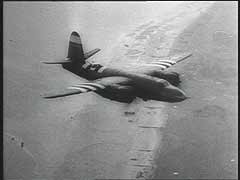
The German army (Wehrmacht) regarded the war in the east as a crusade against communism and not subject to the "normal rules" of war. After the German invasion of the Soviet Union in June 1941, Soviet soldiers followed a "scorched earth" policy to hinder the German advance. In this German newsreel footage, German soldiers approach a burning village, one of many destroyed during the invasion of the Soviet Union.
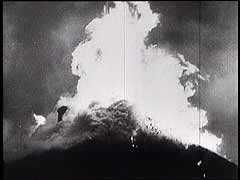
German forces launched Operation "Barbarossa," the invasion of the Soviet Union, on June 22, 1941. The German army made rapid initial progress in the campaign into Soviet territory. In this German military footage, German soldiers separate women and children from men in a Soviet village.
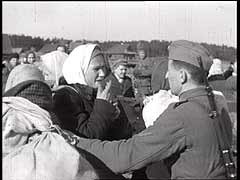
Soviet troops entered the Auschwitz killing center in January 1945 and liberated thousands of sick and exhausted prisoners. This Soviet military footage was filmed shortly after the camp was liberated. It shows Soviet doctors examining victims of sterilization, poisonous injection, and skin graft experiments.
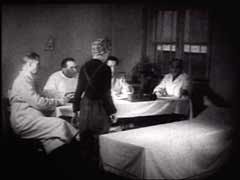
The Medical Case was one of 12 war crimes trials held before an American tribunal as part of the Subsequent Nuremberg Proceedings. The trial dealt with doctors and nurses who had participated in the killing of physically and mentally impaired Germans and who had performed medical experiments on people imprisoned in concentration camps. Here, chief prosecutor Brigadier General Telford Taylor reads into evidence a July 1942 report detailing Nazi high-altitude experiments and outlines the prosecution's goals…
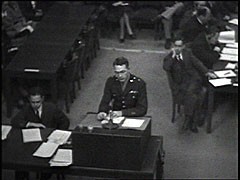
We would like to thank Crown Family Philanthropies, Abe and Ida Cooper Foundation, the Claims Conference, EVZ, and BMF for supporting the ongoing work to create content and resources for the Holocaust Encyclopedia. View the list of donor acknowledgement.